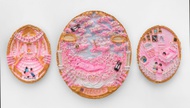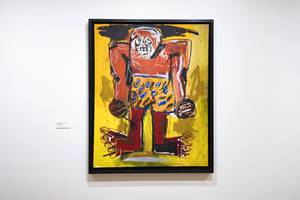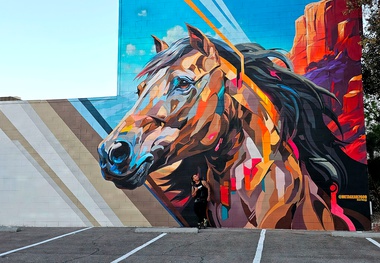
Sean Slattery: The First 100 Days Through March 30; Tuesday-Friday, 10 a.m.- 8 p.m.; Saturday, 9 a.m.-6 p.m.; free. Winchester Cultural Center, 702-455-7340.
Mischievous. Zany. Thoughtful. Accomplished. Incisive. Finding adjectives to describe Sean Slattery’s The First 100 Days is easy, but summing it up is a challenge. A multimedia weave of allusion, reproduction, reference and fiction, the exhibition reaches beyond the Winchester Gallery and into the unpredictable world of the Trump White House. In many ways, Slattery’s “art” is not actually on display. The genius of the show is how the art objects in the gallery belong to a digital network of shifting contexts and truths.
Spanning the main wall are 86 hand-drawn comic-strip templates arranged in rows. The strips replicate, in order, actual Dilbert comics published Monday-Saturday during the first 100 days of the Trump administration. In pencil, with false how-to-draw-a-comic guidelines, Slattery faithfully reproduces the first two panels of each digital strip but alters the third. The QR code on each drawing links to a corresponding video, in which the character “Sean Slattery” explains and critiques the day’s strip, switching out the last panel once again, this time quoting from Garfield.
The substitutions—from original Dilbert to fake drawing to performance video—provide a humorous but biting critique of the Trump White House and the instability of public information. On April 27, for example, in Scott Adams’ original Dilbert, Pointy Haired Boss defined corporate culture by its “honesty,” but in Slattery’s fake Dilbert, the word “honesty” is replaced with “yellow” (symbolizing cowardice), while in the corresponding video, Slattery describes the same April 27 comic strip, but this time “honesty” as a value is met with the punch line, “I’ve got some bad news for you.” “Honesty” doesn’t simply disappear from the narrative—it’s appropriated, redeployed and negated like other information in the public sphere.
On another wall, 13 medium-format digital prints riff on the Dilbert theme in a blue/green/violet palette, showcasing both Slattery’s talent as a colorist and his adroit compositional skill. Three works include actual “cels”—short for “celluloids”—from the Dilbert animation. In “Dog Whistle,” for example, abstract white shapes threaten Dilbert; the caption reads, “what have we done.” The white shapes resemble KKK hoods and display coding, communicating a kind of robotic menace, while the cartoon character, as cel, literally raises issues of transparency. A panicked Dilbert, the works suggests, has authored his own demise.
While Slattery’s performance videos could be tighter, and the busier prints—sporting sly reproductions of an unattractive Trump mouth—are less convincing, he still effectively makes his point. Dilbert’s corporate culture links to, if not supports, Trump culture. Slippages between the “real” Dilbert, the pencil Dilbert, the video performance of Dilbert and the cel Dilbert illustrate the process Slattery sets out to critique: Fictions not only hide the truth—they become the truth.







